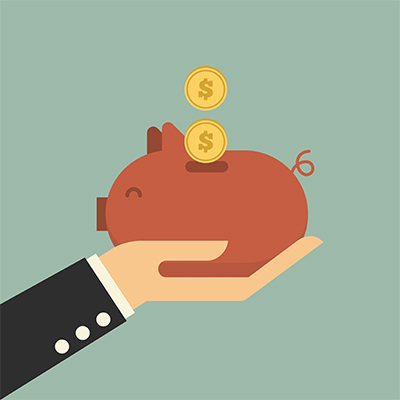
AT 52, LESLIE has a clear view of her retirement, and it doesn’t involve drawing on a 401(k). It involves 1,100 sun-drenched square feet surrounded by fruit trees, walking distance to Mill Valley shops and restaurants, plus a guest cottage.
“All I have is my house,” says Leslie, a mother of two who operates two home businesses. In a climate of soaring property values and rents, and with the advent of Airbnb, Leslie is one of many Marin residents looking to her house to play a strong supporting role in the retirement plan.
In years past, the house meant security for Leslie; when she lost her job in 2009, she says, “I was able to sleep at night because I knew if things got bad I could always go live in my rental unit and rent out my house.”
Moving the unit from the long-term residential market to Airbnb increased her rental income to about $3,200 a month — enough to pay her mortgage, insurance and property taxes. That frees up her other income to invest in the future — which for Leslie means adding to her main house an extra room with a separate entrance, which she plans to rent on Airbnb as well.
Leslie’s story illustrates how several years of strong economic growth have inspired more Marin residents to shift their financial thinking from just getting along to planning for the future.
“I’m having more conversations [with clients] about retirement,” says Kathleen Nemetz, a certified financial planner with McClurg Capital in San Rafael.
With the strong U.S. dollar and the flexibility brought by the sharing economy, Nemetz says she is seeing more clients and friends consider spending all or some of their time abroad.
Attorney Julie Garfield, 62, plans to tap the earning potential of her four-bedroom, two-and-a-half-bath San Rafael ranch home as she transitions from part-time work to full retirement over the next seven years.
“My retirement plan calls for me to move as often as every three to five months between three home bases I have already established, in Nice, France; San Miguel de Allende, Mexico; and Marin. That revolving change of scene, personalities, activities, languages and regional travel options promises to keep things interesting for me for so long as I am able to move about freely,” Garfield says. When she’s not in Mexico, her condo there can generate income via Airbnb competitor VRBO. Not wanting to give up her foothold in Marin, Garfield prefers to rent bedrooms to roommates instead of converting her whole home into a rental property, giving her the flexibility to move back full time when she wants to.
Hedging your bets like this gets Nemetz’s approval.
“If you’re making a long-term commitment to living abroad, try renting first before you buy that property in Tuscany,” Nemetz suggests. You may have loved Tuscany on vacation, but will you love living there year round? What will you do for medical care while you live there? Do you understand the local real estate laws? These are all questions would-be expats can address during a trial stay, Nemetz says.
Is It Too Late to Buy Real Estate?
Planners say they are also having conversations with clients about another issue: buying property. Soaring home prices are great for those thinking of cashing in, but a towering barrier for those who want to become homeowners or landlords. That’s not to say that no one should consider buying a home at current prices, says Evan Oliver, of Sausalito’s Verity Wealth Advisors. Buying property in Marin just shouldn’t be considered an investment at this point.

“You’ve just got to forget about any potential appreciation. Not that it won’t be there, but you can’t let that be the driver behind buying a house,” Oliver says. People should buy a home if the pleasure they’ll derive from living in their own home outweighs the pleasure they might derive if they invested elsewhere the considerable funds they’ll pay, he says.
One thing Oliver advises against for most people: taking the down payment from your 401(k).
“When you start to see people tap into retirement plans, 90 percent of the time or maybe more they’re doing it because they have no other way to buy it, which means that the purchase is a bit of a stretch anyway, and it may not be the thing to do,” Oliver says.
The unavailability of local real estate as a viable investment is tough, as it coincides with continuing low interest rates, uninspiring bond performance and a long run-up in stock prices. Where to put investment funds?
For Dino Wilson, an agent with Paragon Real Estate Group in Greenbrae, the answer is Sonoma. He’s helped more than half a dozen clients acquire rental properties at “still very affordable” rates in Santa Rosa, Rohnert Park and Boyes Hot Springs, and he’s a landlord there himself. While you would be hard-pressed to recoup the purchase price for a Mill Valley condo in rents, that’s still feasible in Sonoma, he says.
“I still do a great deal of my work in Marin, but I’m seeing the next 10 years of growth in Sonoma. And with the (Larkspur to Cloverdale) SMART train up and running, that’s going to open the door for commuters to feel they can live in Sonoma County and not have to sit on the freeway,” Wilson says.
Marin residents’ income has been growing, with median household income approaching $91,000 as of 2013, up 15 percent from 2011, and forecast to keep growing, according to the Marin Economic Forum. When folks are earning more, the perpetual desire to minimize the tax burden intensifies. We are often told to put as much of our earnings as possible into tax-deferred retirement accounts, and advisers say many clients ask about opportunities beyond the 401(k) or IRA to defer taxes, such as setting up defined benefit plans, for those that are self-employed.
But Oliver warns that putting all your investments into plans that will be taxed later could be a mistake, because it’s quite possible that you will face higher tax rates after you retire.
“If you think taxes are bad now, there are scenarios where they could get much worse. If you’re focusing all your tax planning on today, you could make mistakes that could cost you down the road,” Oliver says. Besides the taxes you’ll pay on your retirement benefits, you also need to think about Medicare, which might hit you with surcharges if your income from deferred-tax accounts is great enough to push you into the affluent category.
“What we try to do is talk about tax diversification,” Oliver says. That means that in addition to contributing to a 401(k) or IRA, he advises clients who qualify to put money into a Roth IRA, plus maintain a taxable investment account. That way you are paying some taxes at today’s rate and some at the unknown future rate. Another advantage of a Roth is that unlike with a regular IRA or 401(k), withdrawals don’t count toward Medicare’s income limits.
Bob Goldman of Bob Goldman Financial Planning, also in Sausalito, offers another good reason for parking some earnings in a taxable investment account: liquidity.
“If you need money for cash flow, you won’t have to turn to your retirement accounts, where every dollar will be taxed at ordinary income-tax rates — plus, a 10 percent penalty if you’re under 59.5 years of age,” Goldman says. “If you have that taxable investment account, you can handle your cash flow needs from those assets, pay lower cap gains rates and no penalties, and leave your retirement accounts to grow, tax deferred.”
In fact, a recent report from the Center for Retirement Research at Boston College warned that withdrawals from retirement accounts — such as cash-outs when you change jobs or withdrawals to pay for a home purchase or emergency expense — shrink Americans’ wealth in retirement by an average of 25 percent.
Hedge Your Bets
Overall, many Marin residents are reaping the benefits of a growing economy and looking to their wealth managers or financial advisers to help them make the most of it. The best managers help their clients enjoy the good times without getting carried away.
“Things are better and people are more optimistic,” Nemetz says. “The thing I would say to them is, ‘Don’t forget your business discipline. If you’re making decisions based on feeling good today, don’t forget to look at the numbers.’”
Kenneth Maring, senior portfolio manager with the Maring Financial Strategies Group of Wells Fargo Advisors in San Rafael, suggests being realistic about the stock market, where the bulls can’t run forever.
He finds safety in stocks that pay good dividends, and he favors an “absolute return strategy,” a hedge fund approach designed to make money every year, whether the market is trending up or down. Maring handles portfolios of $250,000 or more, but smaller investors can seek out absolute return mutual funds, he says.
“This is a time in history that you need to be extremely cautious with your investments. Slow down — the curve is coming,” he warns.
This article originally appeared in Marin Magazine’s print edition under the headline: “The New Economy.”


